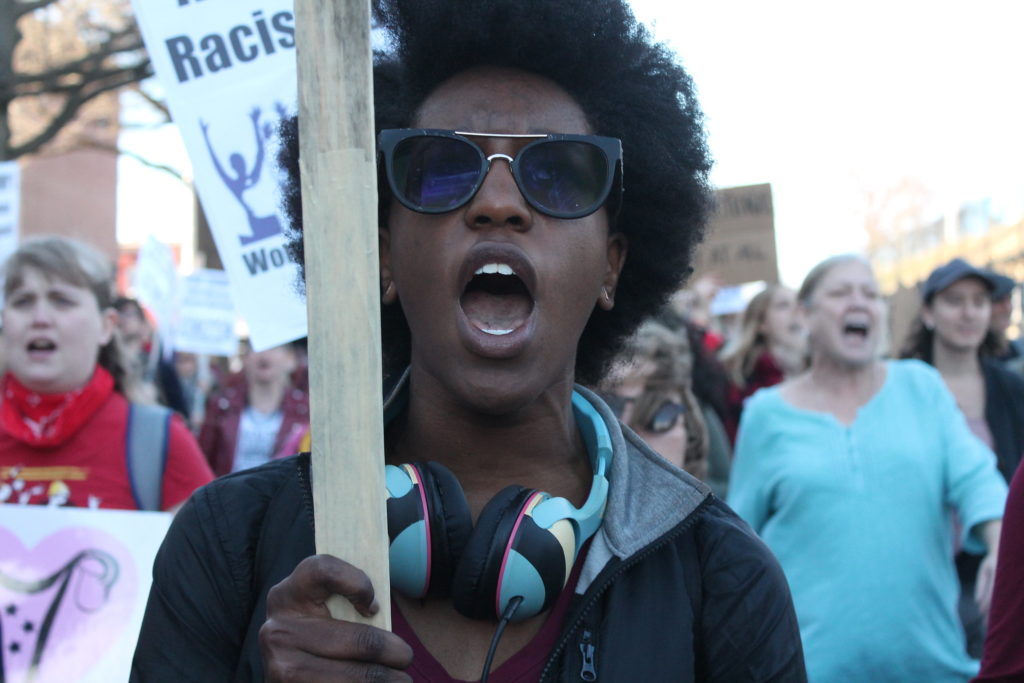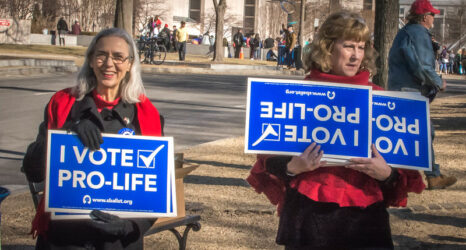As more details emerge in the next days and weeks about the mass shootings in El Paso, Texas, and Dayton, Ohio—and as policy makers and communities debate what must be done to stop the deadly violence—we want to underscore that anti-feminism has long been a gateway into violent extremism. This piece, excerpted from our Spring 2019 issue, connects many of the dots between white supremacy, anti-feminism and public violence.

The contemporary men’s rights movement has roots in the “men’s liberation” movement of the 1970s, which was not incompatible with feminism in that its members were chiefly interested in rewriting gender expectations. But by the 1980s, men’s rights activists began to see them- selves as explicitly anti-feminist. Instead of critiquing gender roles, they began to critique feminists—without whom everything would still be great, or so they believed.
In 1993, Warren Farrell became the father of today’s movement with his bestseller The Myth of Male Power, which argued that men are as oppressed as women, or even more so. By the 1990s, as women gained ground in education, employment and political representation, it became easier to argue that the fight for women’s equality was no longer needed. Continued calls for expanded women’s rights could be cast as dangerous and overreaching because, explains Kristin Anderson, psychologist and author of Modern Misogyny, “if you assume the playing field is level, then any complaint about sexism is read as man-hating.”
Men’s rights groups espouse what could be considered an upside-down version of feminism. For example, they might be upset over gendered expectations that boys not show emotion, outdated notions of chivalry or the fact that men typically receive shorter parental leave—all targets of feminist critique—and use them as examples that women are secretly running the show. Oftentimes, they recognize the problem but make dangerously wrong conclusions about who has real power.
Today, the men’s rights movement is a loose coalition of online communities often called the “manosphere.” There are different pockets, each with their own core identities. There are self-declared men’s rights activists (MRAs) and pickup artists (PUAs), men going their own way (MGTOW) and involuntary celibates (incels).
Anti-feminism has long been a unifying force on the far right, bridging some of the gaps between groups such as white nationalists and evangelical Christians. Because of this, men’s rights groups are often a gateway to other violent ideologies that blend misogyny with racism, anti-Semitism, transphobia and more. There’s a particularly strong correlation between misogyny and white supremacy, an ideology with a deep history of violence against African Americans and immigrants.
Individual men are often enticed into the manosphere by what they see as an explanation for their personal unhappiness. Too often, it’s women. Their websites are “like wildlife refuges for misogynist ideas,” wrote journalist David Neiwert in his recent book, Alt-America: The Rise of the Radical Right in the Age ofTrump.
The manosphere drew national attention in 2014 with the killing spree of self-declared incel Elliot Rodger near the University of California, Santa Barbara, and Gamergate, in which male supremacists and members of the alt-right led a coordinated online harassment campaign against feminists in the gaming industry.
These online communities involved in both incidents have since been recognized as dangerous and are now being tracked by both the Southern Poverty Law Center (SPLC) and the Anti-Defamation League (ADL). In 2018, the SPLC for the first time classified male supremacy as a distinct ideology of hate, noting that, “like white supremacy, male supremacy is driven by fear and anger at the loss of white male status.”
A 2019 ADL report on violence and extremism linked a 2018 shooting at a yoga studio in Tallahassee, Fla., to the misogynistic incel movement. The attack followed a similar shooting spree in Toronto and Rodger’s in California. The ADL now tracks incel-linked murders and says it “considers misogyny a dangerous and underestimated component of extremism.”
In that same report, the ADL drew a line connecting men’s rights groups to Trump’s election. “Donald Trump’s 2016 victory—secured after a recording of the candidate bragging about sexually assaulting women was made public— was a glorious vindication of misogynists’ worldview,” the report says. “Some of [his] voters presumably saw Trump as a corrective, a bulwark against the fear that their privileged status—as men, as white people—is at risk.”
For many in the U.S., the 2016 presidential election burst the illusion of women’s perceived equality. Trump’s victory was a slap in the face to those who believed the country had moved past its openly racist and misogynist ways. Other voters saw the election as a defense against feminist excess. In Trump, men’s rights activists found a man who was willing to fight their fight.
Like Donald Trump and Brett Kavanaugh, the typical member of the manosphere is a white, heterosexual man. Some are younger men who feel alienated in the dating world; some are older men who have gone through a divorce or difficult custody battle. Men’s rights groups have traction because they appeal to individual men’s feelings of disempowerment, according to Matthew N. Lyons, an independent researcher who studies right-wing movements.
When these men are called out for their racism or their misogyny, they feel victimized. According to psychologist Anderson, many men feel personally targeted whenever they are presented with a critique of male power or patriarchy. “A criticism of sexism is a criticism of the man you’re telling that to, so you can be talking about patriarchy and sexism that has nothing to do with him individually in that moment and he sees it as an attack on him,” she says. “He can’t understand the structural nature of sexism, that it’s built into our institutions and our cultural practices.”
That’s where the danger is. Men’s rights groups paint any feminist activism as a full-scale attack on all men. Unlike Trump and Kavanaugh, most men’s rights supporters don’t hold national-level political positions. If such men can be cast as martyrs of a feminist power grab, it’s not hard to make a regular Joe feel like one too.
This piece is excerpted from a feature in the Spring 2019 issue of Ms. Become a member today to read more coverage like this each quarter, in print and on your digital devices.





